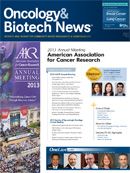Adding Paclitaxel to Neratinib Improves Outcomes Versus Monotherapy
Combining paclitaxel with the investigational compound neratinib increased response rates versus neratinib alone in patients with HER2-positive metastatic breast cancer.
Louis W.C. Chow, MD
Combining paclitaxel with the investigational compound neratinib (HKI-272) increased response rates versus neratinib alone in patients with HER2-positive metastatic breast cancer. While toxicity was also higher with the combination, the side effects were considered manageable. The results come from a phase I/II trial published in the British Journal of Cancer.
Increased HER2 expression is observed in approximately 20%-30% of breast cancer patients, and HER2-targeted therapies, such as trastuzumab (Herceptin) and lapatinib (Tykerb), have improved clinical outcomes overall. However, not all patients respond to these agents, and others become resistant following an initial response. The need for novel agents in this setting, particularly after prior treatment failure, was the rationale for this neratinib analysis.
Neratinib is an irreversible tyrosine kinase inhibitor of the ErbB family of receptors, which, in addition to HER2, includes EGFR and HER4. Its efficacy has been demonstrated in previous phase I and II trials in patients with HER2-positive breast cancer, including patients with prior exposure to trastuzumab.
This open-label study, lead by Louis W.C. Chow, MD, medical director of the Comprehensive Centre for Breast Diseases at the UNIMED Medical Institute in Hong Kong, was designed as a two-part study. The first part involved a dose-escalation analysis to determine the maximum-tolerated dose (MTD) of neratinib plus paclitaxel in patients with solid tumors. In the second part of the study, the safety, efficacy, and pharmacokinetics of the combination at the MTD were assessed in patients with HER2-positive breast cancer.
The dose-escalation portion of the study included eight patients. The researchers did not observe any dose-limiting toxicities and determined that the MTD was 240 mg of neratinib once daily plus 80 mg/m2 of paclixatel on days 1, 8, and 15 of each 28-day cycle.
In the second part of the study, 102 patients with HER2-positive breast cancer were enrolled. The overall median treatment duration among those patients was 47.9 weeks (range, 0.1-147.3 weeks).
The most common treatment-emergent adverse events (any grade, grade ≥3) included diarrhea (92%, 29%), peripheral sensory neuropathy (51%, 3%), neutropenia (50%, 20%), alopecia (46%, 0%), leukopenia (41%, 18%), anemia (37%, 8%), and nausea (34%, 1%). Three patients in the study (3%) discontinued treatment due to adverse events including mouth ulceration, left ventricular ejection fraction reduction, and acute renal failure.
In the second part of the study, the overall response rate (ORR) among 99 evaluable patients was 73% (95% CI, 62.9-81.2), with seven patients (7%) achieving a complete response and nine patients (9%) achieving stable disease for at least 24 weeks. Among patients with ≤1 prior chemotherapy regimen and no prior lapatinib, the ORR was 71%. Among patients with two or three prior chemotherapy regimens and lapatinib allowed, the ORR was 77%. The median progression-free survival was 57 weeks (95% CI, 47.7-81.6).
Pharmacokinetic analyses found no interaction between neratinib and paclitaxel.
The researchers concluded that while the combination of neratinib and paclitaxel was associated with higher toxicity than neratinib alone, the adverse events were generally manageable through the use of anti-diarrhea agents and dose reductions. Additionally, the high rate of responses observed in patients with HER2-positive breast cancer suggests that this combination should be further studied in the first-line setting, which is the focus of an ongoing phase III clinical trial.
Chow L W-C, Xu B, Gupta S, et al. Combination neratinib (HKI-272) and paclitaxel therapy in patients with HER2-positive metastatic breast cancer. Br J Cancer. 2013;108(10):1985-1993.




